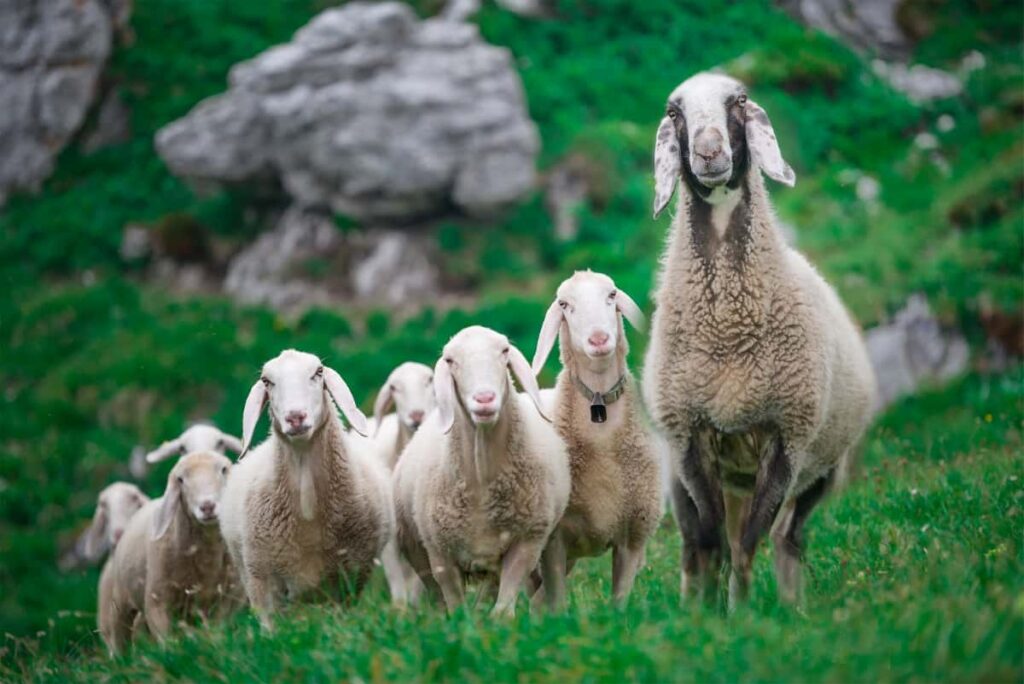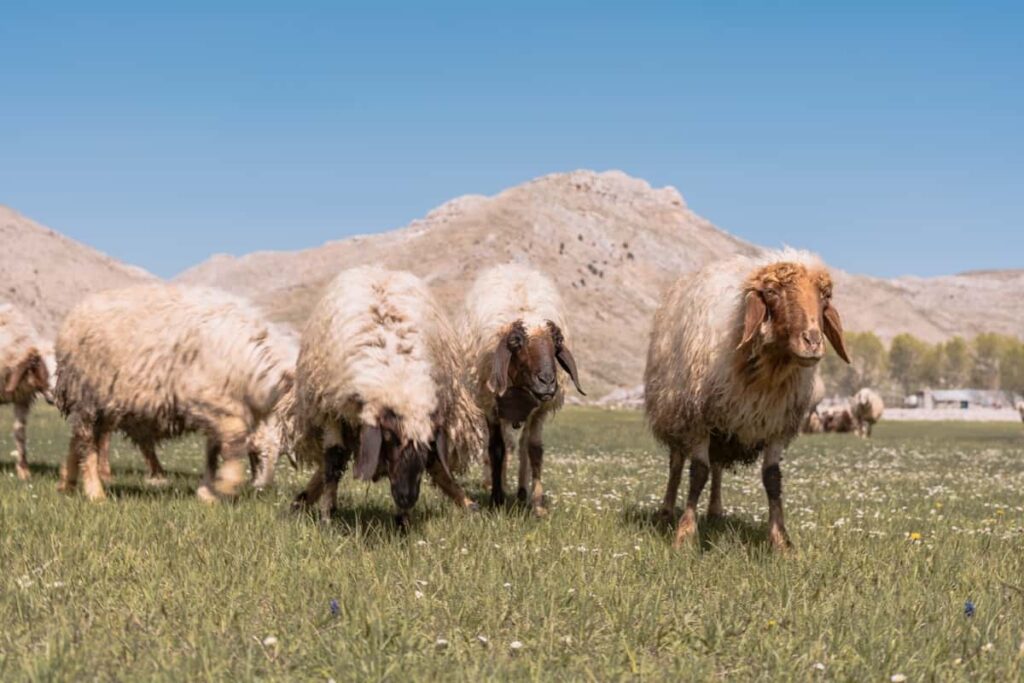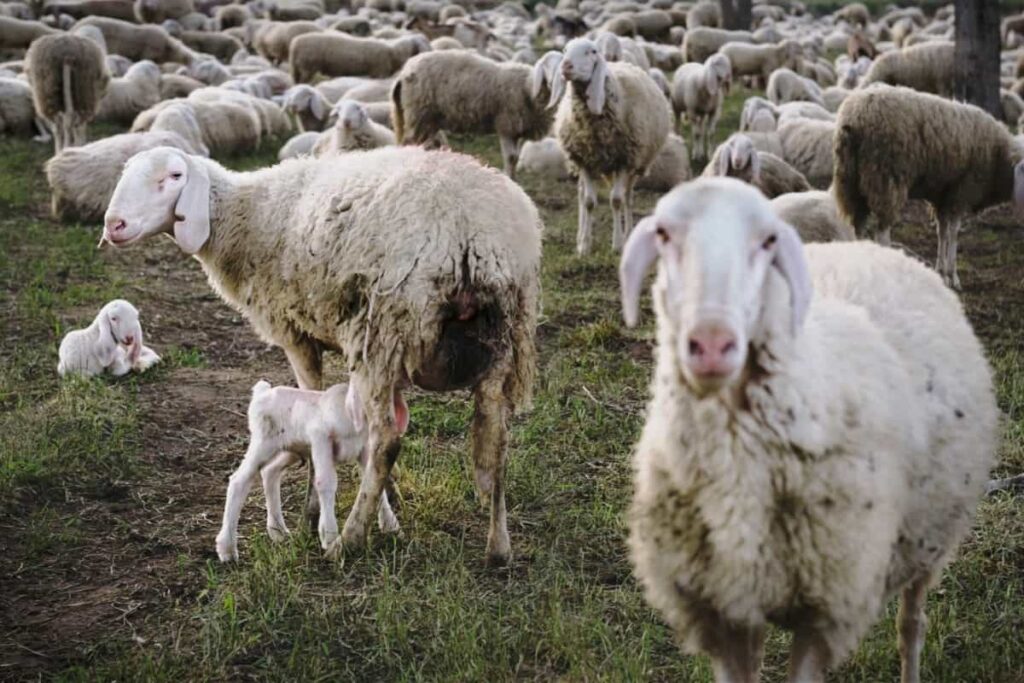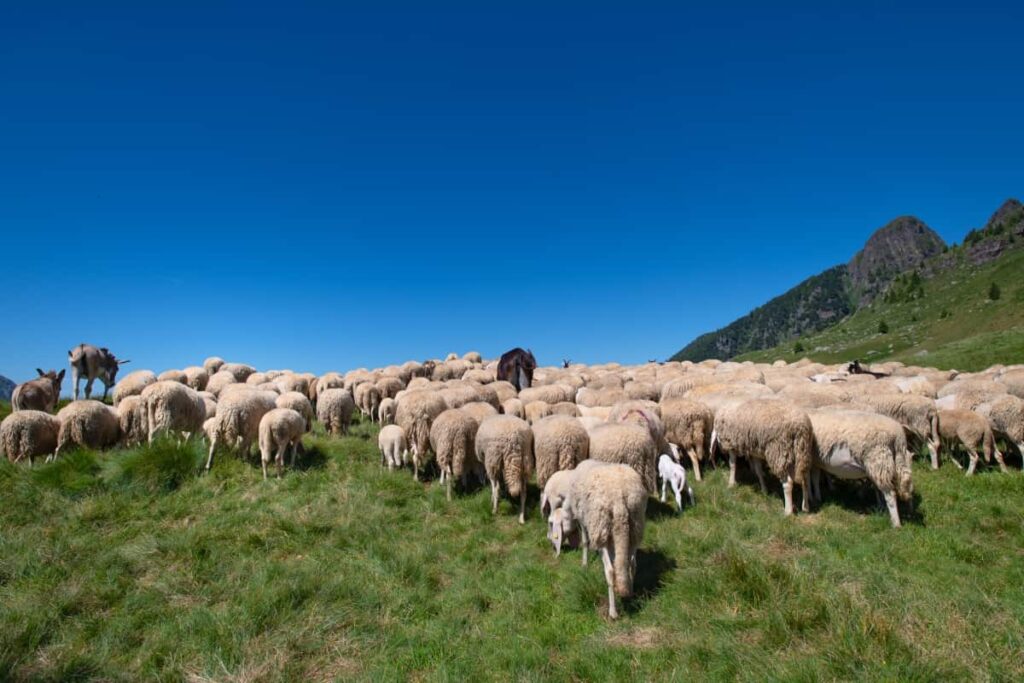The story of Biellese sheep traces back centuries to the Biella region of northern Italy, nestled within the picturesque landscapes of the Alps. Historically, these sheep were bred by local farmers who recognized their exceptional qualities and adaptability to the rugged terrain of the region.

All You Need to Know About Biellese Sheep
Distinct Characteristics of Biellese Sheep
- Adaptability: Known for their adaptability to mountainous terrain and harsh climates.
- Physical Appearance: Typically white with distinctive black or brown markings on their face and legs.
- Medium-sized: They are medium-sized sheep well-suited for grazing in alpine pastures.
- Wool Quality: Known for producing high-quality wool, prized for its softness and warmth.
- Herding Instinct: Exhibits strong herding instincts, making them well-suited for extensive grazing systems.
- Temperament: With a gentle and docile temperament, Biellese sheep are easily managed, making them ideal for both experienced shepherds and beginners alike.
Selecting Biellese Sheep for Your Farm
Evaluating Breeding Stock
- Wool Quality: Choose sheep with dense, fine wool that is free from defects or impurities.
- Health and Vitality: Inspect potential breeding stock for signs of good health and vitality, including bright eyes, alert demeanor, and a glossy coat.
- Reproductive Performance: Select breeding animals with a proven track record of reproductive success, including high fertility rates.
Sourcing Healthy Biellese Sheep
When sourcing Biellese sheep for your farm, prioritize obtaining animals from reputable breeders or sources with a history of responsible breeding practices. Ensure that the sheep have been raised in clean and sanitary conditions, free from infectious diseases or parasites. Before purchasing or acquiring Biellese sheep, conduct thorough health checks and obtain veterinary certificates confirming their health status.
Housing and Facilities
Sheep Shelter Design
Construct a sturdy shelter that protects from harsh weather conditions, including wind, rain, snow, and extreme temperatures. Ensure adequate insulation and waterproofing to maintain a comfortable environment year-round. Use clean and comfortable bedding materials, such as straw or wood shavings, to provide cushioning and insulation.
Proper Ventilation and Space Considerations
Install windows, vents, or ridge openings to allow fresh air to enter the shelter and escape stale air and odors. Aim for a minimum of 15-20 square feet per adult sheep to prevent overcrowding and minimize stress. Design the shelter with convenient access to pasture or grazing areas, allowing sheep to graze freely and engage in natural behaviors. Incorporate gates or fencing to facilitate rotational grazing and pasture management.
Biellese Sheep Nutrition and Feeding
Nutritional Requirements of Biellese Sheep
- Forage: Grazing on high-quality pasture is the foundation of the Biellese sheep diet, providing essential nutrients and fiber for optimal digestion and health.
- Supplementation: Supplement pasture with high-quality hay, grains, or commercial sheep feed to meet specific nutritional needs, especially during periods of increased energy requirements such as gestation, lactation, or growth.
- Mineral Supplements: Provide access to mineral supplements or mineral blocks formulated specifically for sheep to prevent deficiencies and support overall health and productivity.
Seasonal Diet Adjustments
Adjust the sheep’s diet seasonally to account for changes in pasture quality, availability, and nutritional content. During the winter months or when pasture quality is low, increase supplementation with hay or concentrate feeds to meet energy requirements. Conversely, reduce supplementation during periods of abundant pasture growth to avoid excessive nutrient intake.
Healthcare and Disease Prevention
Common Health Issues in Biellese Sheep
Parasitic Infections: Internal parasites like worms can negatively impact sheep health and productivity. Implement regular deworming protocols based on fecal egg counts and pasture management practices to control parasitic infestations.
Foot Rot: Foot rot is an infection caused by bacteria affecting the hoof tissues, leading to lameness and discomfort. Practice good hoof hygiene, provide dry and well-drained living conditions, and promptly treat affected individuals with appropriate antibiotics.
Respiratory Diseases: Respiratory infections can occur, particularly in crowded or poorly ventilated environments. Maintain proper ventilation in sheep shelters, minimize stressors, and consider vaccination against common respiratory pathogens.
Vaccination and Regular Check-Ups
Vaccinate against prevalent diseases such as clostridial diseases (e.g., tetanus, enterotoxemia), as well as common respiratory infections, to prevent outbreaks and minimize disease risk. Schedule regular check-ups and health assessments for your flock, including dental exams, hoof trimming, and body condition scoring. Early detection of issues allows for timely intervention and treatment, ensuring the long-term health and productivity of Biellese sheep.
In case you missed it: Sheep Farm Operations Management: Month-Wise Maintenance For Better Profits

Biellese Sheep Wool Production
Wool Characteristics of Biellese Sheep
- Softness: Biellese wool is renowned for its soft texture, making it suitable for various clothing and textile applications.
- Crimp: Biellese wool typically exhibits a high crimp, adding resilience and elasticity to the fibers, which enhances their spinning and weaving properties.
- Color: Biellese wool may come in various natural colors, including white, shades of grey, and brown, offering versatility in dyeing and textile design.
Shearing Techniques and Schedule
- Gentle Handling: Handle sheep gently during shearing to minimize stress and prevent injuries. Use proper restraint techniques and maintain a calm environment.
- Regular Schedule: Shear Biellese sheep annually, preferably in the spring or early summer months, to remove excess wool and prepare them for warmer weather. Avoid shearing during extreme weather conditions or when sheep are heavily pregnant.
Breeding Biellese Sheep
Managing Ewes and Rams
- Health: Ensure that ewes and rams are in good health and free from diseases or conditions that may affect fertility or reproductive success. Provide adequate nutrition and access to clean water to support optimal reproductive function.
- Monitoring: Monitor the reproductive status of ewes and rams closely, including estrus cycles in ewes and libido in rams, to optimize breeding timing and maximize conception rates.
Breeding Season and Pregnancy Care
Typically, breeding season occurs in the fall or early winter, allowing for springtime lambing when forage is abundant. Provide appropriate care for pregnant ewes, including Nutritional supplementation to support fetal development and lactation. Regular health checks to monitor pregnancy progress and detect any complications.
Lambing and Care of Young Sheep
Preparing for Lambing Season
- Providing clean and comfortable lambing pens or sheltered areas for ewes to give birth.
- Stocking up on essential supplies, including clean bedding, obstetrical equipment, and newborn care products.
- Consulting with a veterinarian or experienced shepherd for guidance on managing lambing complications and emergencies.
Caring for Newborn Lambs
- Administer colostrum to lambs within the first 24 hours to provide essential antibodies and nutrients.
- Monitor lambs closely for signs of weakness, hypothermia, or illness and intervene as needed.
- Provide a clean and warm environment for newborn lambs.
- Implement a schedule for routine health checks, vaccinations, and nutritional supplementation.
Sheep Health Management and Record-keeping
Maintaining Health and Productivity
- Nutritional Management: Provide a diet tailored to the specific needs of your flock, ensuring access to high-quality forage, supplementation, and mineral supplements as needed.
- Parasite Control: Implement a parasite control program based on fecal egg counts and pasture management practices to prevent parasitic infestations and maintain flock health.
- Vaccination and Preventive Care: Vaccinate sheep against common diseases and schedule regular health checks and preventive treatments, such as deworming and hoof trimming, to minimize disease risk and maintain optimal health.
Record Keeping for Better Management
- Individual sheep identification, including ear tags, tattoos, or electronic identification.
- Health and vaccination history, including dates of treatments, medications administered, and health status.
- Breeding records, including mating dates, pregnancy status, and lambing outcomes.
- Production data, such as wool yields, lambing rates, and growth performance.
In case you missed it: Dairy Sheep Farming: Raising from Scratch for Breeding to Marketing

Marketing Wool and Sheep Products
Marketing Strategies for Wool
Highlight the softness, warmth, and durability of Biellese wool. Utilize online platforms and local markets to showcase products, targeting fiber artists, textile manufacturers, and specialty retailers. Collaborate with artisans and participate in wool festivals to promote unique qualities. Emphasize sustainability and quality to attract discerning customers.
Selling Biellese Sheep and Their By-Products
Sell Biellese sheep directly to farms or individuals for wool, meat, or breeding. Explore value-added products like gourmet lamb cuts and lanolin-based skincare. Advertise through online classifieds, agricultural networks, and local events. Offer unique by-products like sheepskin rugs to appeal to niche markets and capitalize on local demand.
In case you missed it: How to Make Silage for Livestock: Business Plan, Preparation Process for Goats, Sheep, Pigs, and Cows

Conclusion
This comprehensive guide has illuminated the historical significance, distinctive characteristics, and practical management techniques essential for raising Biellese sheep. With Biellese sheep care, attention to nutrition, and strategic breeding, Biellese sheep enthusiasts can nurture thriving flocks and cultivate premium wool products, ensuring a prosperous and sustainable future.
Note: The images presented in this post are intended solely for representation purposes. The images are meant to serve as visual aids and should not be relied upon as accurate representations of their real-life counterparts.
- Aquaponic Farming at Home: A Step-By-Step Guide
- Profitable Village Farming Business Ideas in 2024
- High-Yield Aquaculture: Fast-Growing Fish for Farming
- Effective Fish Pond Construction Techniques for Beginners
- Irrigation and Water Management in Pineapple Farming
- Blossom to Harvest: Mastering Flowering and Pollination in Papaya Farming
- Pig Fattening Essentials: From Selection to Sale for Beginners
- Raising Wagyu Cattle: A Complete Guide for Premium Beef Production
- Soil Types and Their Water Holding Capacity
